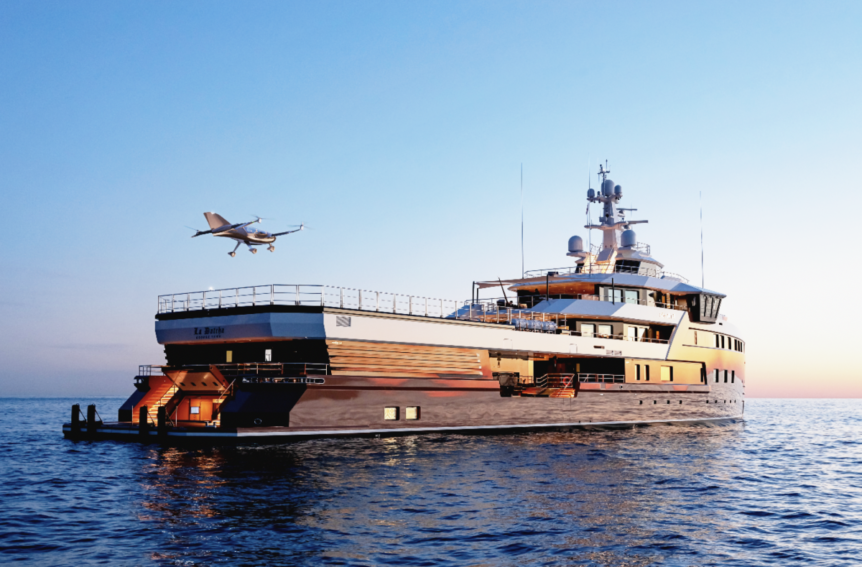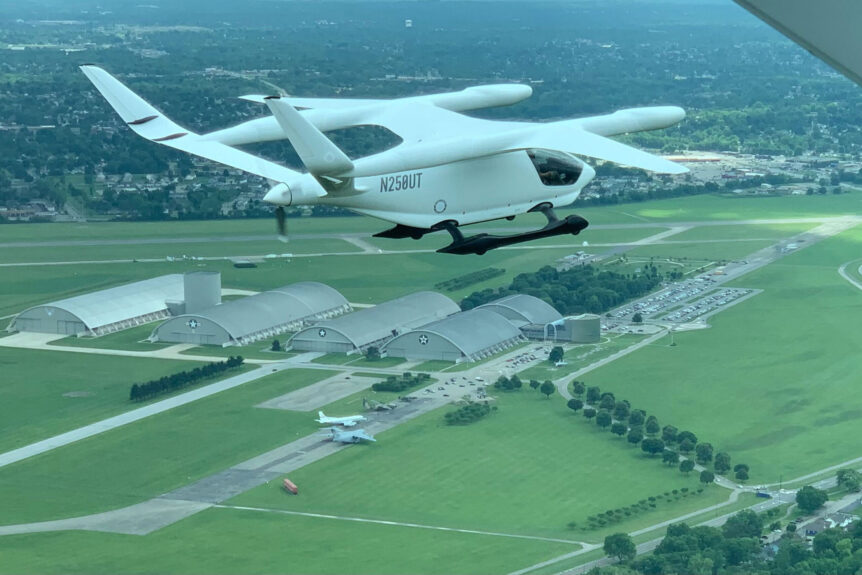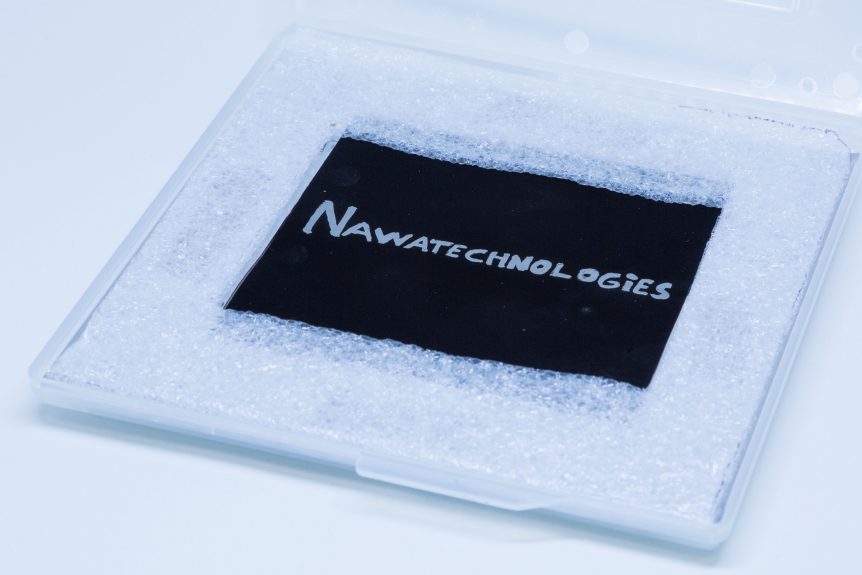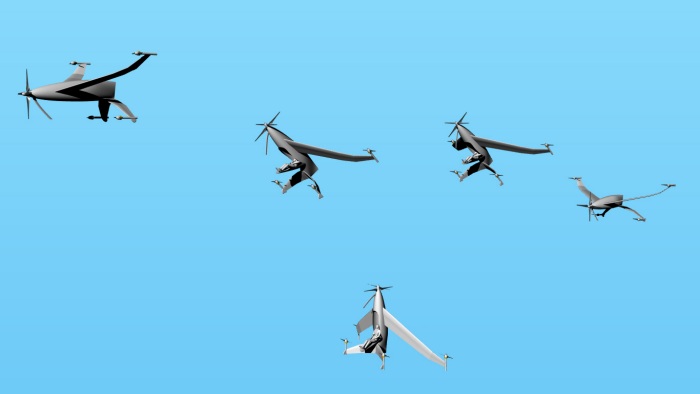A flying machine in your two-car garage was the promise heralded by Popular Science and Popular Mechanics magazines during the 1950s and 1960. It was the era of Bob Cummings piloting his Aerocar on his popular TV show, and KISN radio watching over traffic with one in Portland, Oregon. Expectations were high and often disappointed. High costs of establishing a network of two-ton, four-passenger eVTOL (electric Vertical Take Off and Landing) machines dissuaded even Uber from pursuing that goal. Consider that skyports, vertiports, or whatever they ended up as are enormously expensive, and a network with charging stations and passenger accommodations would be a large investment. Beyond that, each sky taxi would cost well into the high six figures, something that would require corporate ownership rather than the owner/driver model on which Uber’s land-based operations depend. At least four eVTOLs are now on the market or headed there. None cost more than a claimed $150,000 base price, a plausible outlay …
Beta’s Alia Makes a Highly-charged Trip
Beta Technologies has taken an all or nothing approach from its beginning, designing charging stations and flight crew centers to complement its aerial vehicles. Last month, Beta got a chance to show at least part of its cross-country ambitions. A Six-State Outing From May 23 to May 24, Betas Alia 250 eVTOL (electric Vertical Take Off and Landing) aircraft made one of the longest cross-country flights at that time for such a vehicle. Alia did not take advantage of its vertical capabilities, relying instead on conventional runway-borne takeoffs and landings. The total flight from Plattsburgh to Bentonville covered 1,355 miles (2,181 kilometers) and took almost 12 hours – about like a similar flight in a Cessna 172. Charging Stations Beta has planned well-thought-out charging stations to complement the craft and crews. Each 480-Volt station has a landing platform roof, crew quarters with sleeping and bath accommodations and, of course, a charger. The current route included stops where the Beta charging …
NAWA’s Straight Line Electrode to More Power
Most battery breakthroughs are five years in the future, following the basic rules of scientific journals and Popular Science magazine. The usual refrains are, “Further research is required,” and “Researchers expect commercial development within the next decade.” Rather than wait for the future, NAWA Technologies claims the world’s fastest electrode today and production now. NAWA’a brochure explains their Vertically Aligned Carbon NanoTube (VACNT) architecture is “key to its next-generation energy storage.” Think of a forest of carbon nanotubes through which current can flow. In the jumble of usual battery materials, an ion would have to clamber over boulder-like obstructions and possibly get hung up in the random intersections of conductive material. The VACNT architecture allows ionic flow as though they are cruising down a well-maintained interstate freeway. Constructed from carbon and graphene, VACNTs hold the promise of a “quantum leap” in battery performance. NAWATechnologies foresees “revolutionary improvements in power, energy, lifecycle and charging time.” Their Ultra Fast Carbon Electrode contributes …
Dale Kramer’s VLazair – Swinging a Different Way
Dale Kramer’s Lazair was one of the most popular ultralights in the 1980s, selling over 1,200 units. He re-engineered it a decade ago and flew the electrically-powered version in both land and amphibious versions. Appearances at AirVenture saw him making daily flights over the area. Your editor was privileged to visit Dale’s home, once owned by Glenn Hammond Curtis in Hammondsport – who also flew his creations from Keuka Lake, one of New York’s Finger Lakes for which the region is named. Ever an inventive soul, Dale has returned to the drawing board, in his own way answering the question of how to perform vertical takeoffs and landings in a small, light, personal aircraft. To overcome pilot’s getting cricks in their necks, The VLazair has a constant-frame-of-reference seat. The seat swings around during takeoffs and landings to keep the pilot upright, avoiding the rear-view mirror technique used in previous such craft from Convair and Lockheed. VLazair will have a 100-horsepower Rotax …
Your Black Friday (and All-Year) Giving List
With merchants beating the drums of commerce to lure you to their stores and web sites for holiday cheer (at least for the merchants), your editor has some alternative giving suggestions that could help bankroll the future of aviation (if not aviation futures). Each of these projects would welcome funding, and each has much to give back to all of us. Put Your Face in Space The Perlan Project has initiated a fund-raising program on Indie-Go-Go, with the immediate goal to complete construction of the major parts of Perlan II, a high-performance, high-altitude research sailplane recently featured in the New York Times. Its planned mission to 90,000 feet in the Polar Vortex could give us new and profound understanding of global climate change, the ozone hole and greenhouse gases. For a mere $15, you will, “Receive a professionally edited digital video of the entire Perlan Mission II aeronautical exploration, atmospheric science research and record breaking flights.” For another $14, you …
Dr. Seeley at AirVenture 2013
Imagine being able to walk one morning from your front door to a nearby small airport, step into an electrically-powered small airplane, point to a destination on an illuminated map on the airplane’s display screen, and be whisked to your destination so quietly that your passage overhead will not wake your neighbors. This is part of the dream that Dr. Brien Seeley, founder and President of the CAFE Foundation, presented to an appreciable and appreciative crowd on Friday, August 2 at the Rotax Pavilion during the Experimental Aircraft Association’s AirVenture 2013. His talk, “The CAFE Foundation’s Green Flight Challenge Program: Toward a New Transportation Mode,” was a roadmap to how the CAFE Foundation, NASA and corporate sponsors will present five new challenges leading to the type of electric short or vertical-takeoff and landing airplane that will enable neighborhood pocket airports. He also challenged EAA members to become involved, using their technical knowledge and talents to further the development of quiet, …
How Many iPods in a BiPod?
David Bettencourt, a defense attorney in Hawaii and a regular reader of the blog, sent this note about Burt Rutan and his early interest in hybrid power for aircraft. According to David, “A July 2000 Road & Track interview of Burt Rutan regarding the hybrid Honda Insight might be of interest. It stated: “Does he see any application of hybrid propulsion for airplanes? An innocent question, although it leaves Rutan unusually silent. ‘Gee, maybe I shouldn’t disclose this in Road & Track. But at the risk of someone else doing this first, let me tell you about an airplane that would be really interesting to do. This is fascinating….’ “Rutan leans back and stares into middle distance. ‘Visualize an electric airplane with enough batteries to climb to about 500 feet. Actually, it would have several small electric motors with small propellers scattered all around the airplane—some on the tail, some on the wings—so if one motor seized, it’s just a …




